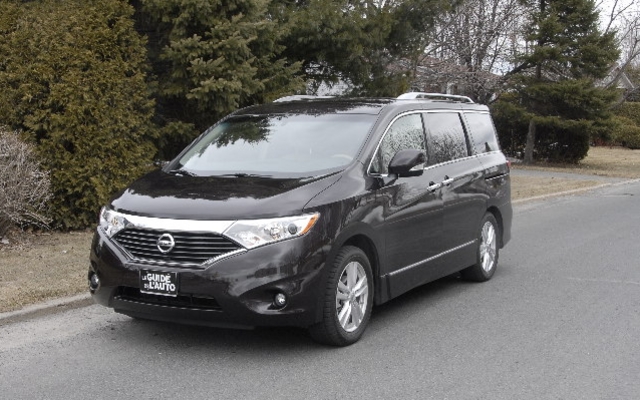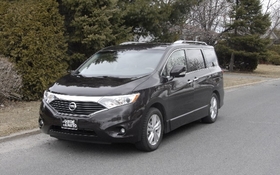2011 Nissan Quest: The family minivan with a peculiar look

| Strong points |
|
|---|---|
| Weak points |
|
Auto manufacturers recognize that minivans have potential. But in an effort to breathe new life into this eminently practical vehicle category, each is using a novel approach. Chrysler, for example, is trying to market the minivan as a vehicle for active men. In their advertising photo, there’s even an athletically built man in front of a minivan, which in turn is in front of a B-25 bomber. So much for the minivan’s reputation as the official soccer mom vehicle.
Nissan has another vision altogether. The previous version of the Quest wasn’t very successful for several reasons, but its shape was almost futuristic, its dashboard looked like it was straight out of a 1950s B-movie flying saucer, and it was very roomy. This time, say good-bye to all the old features – now, it’s more family-oriented than ever. With the Quest, the goal is to transport seven people in great comfort with space left over for their bags. And to set itself apart from the crowd, it’s shaped like a hearse. It’s like a minivan for the Grim Reaper’s mom.
A growing trend
I’ve said it before and I’ll say it again: to each his own. But you have to agree that the transformation is pretty spectacular. The almost sporty lines have been replaced by a more rigid, formal presentation livened up by chrome accents here and there. The stretched metal on the side panels and the huge windows give it an appearance that some might consider strange.
But Nissan isn’t the only manufacturer to introduce a vehicle that could be the key to a funeral director’ success. Take Mercedes-Benz’s innovative R-Class or Lincoln’s MKT, for example. Ford is creating a buzz with the Flex, as well. The Japanese manufacturer follows the trend with its new Quest, but once you get used to the sight of it, it seems to suit its purpose as a luxurious family vehicle. And although that may seem a little odd, if you think about it this silhouette could be the evolution of the old Chevrolet Astro with a few additional refinements and a little more chrome.
The dashboard is a lot less contentious than that of the first generation. It doesn’t follow current trends, but it’s good nonetheless. In fact, the overall presentation of this dashboard looks a lot more like that of a luxury car than that of a family or utility vehicle. The indicator dials are located in a pod with an undulated upper part. In the middle, there’s a speedometer, to the left an RPM counter, and on the right a fuel gauge, thermometer and the transmission indicator.
The shifter is mounted directly on the central console, which is actually an extension of the dashboard. The controls are easy to handle and operate. Moreover, the materials and finish are of excellent quality.
Our test vehicle was equipped with two captain’s chairs for the middle row and a third-row bench, allowing you to carry seven occupants. The middle seats are comfortable and their ingenious fold-down method makes it easy to access the rear seats, which are reasonably comfortable and slightly better than average for the category. Behind this bench is a huge cargo space plus a storage bin can be found under the floor. It’s covered by a detachable cover for easy access. Basically, the layout has been designed for versatility and family use.
Finally, the dual opening glass moonroof – which is uncommon because as a general rule, only the front part opens – is noteworthy. Speaking of openings, the two sliding side doors are electric powered and note that the boarding height is relatively low, catering to children and the elderly. In short, it makes family rides with grandpa, grandma and grandchildren easier. Nissan thought of everything.
Worry-free mechanics
As for mechanics, the engineers used the same platform as before, namely the D platform used on the Altima and Maxima sedans as well as on the Murano utility vehicle. It’s modern, proven and leaves room for a four-wheel independent suspension.
This is Nissan after all, so you’ve already guessed that there are no surprises under the hood. It comes with the incontrovertible 3.5-litre V6 engine and its 260 hp and 240 lbs-ft of torque. This motor’s mission it is to move the Quest. Every year this engine is named among the best on the market and it’s paired with a continuously variable transmission. This type of transmission is annoying to some, but there’s no denying that Nissan is a true master of this technology and it’s hard to find fault with it. This engine doesn’t transform the minivan into a sport vehicle, but it offers excellent balance between performance, accelerations and decent fuel consumption for a vehicle in this category and of this size. We recorded an acceptable 12.4 litres per 100 km on average. Since our test drive took place in April and the vehicle was brand new, fuel economy should be even better as the months go by.
The Quest’s performances aren’t dazzling, but they’re quite decent for a family vehicle. In fact, it takes a little less than eight seconds to cover the traditional 0-100 km/hr. On the road, the vehicle is very well balanced, with a slight understeer if you decide to drive too aggressively in tight turns. In general, the body doesn’t lean unduly and the steering is well-assisted. Basically, it’s honest and well adapted for its purpose. And the suspension deals with potholes and bumps pretty well.
Overall, the shape will please some, but the jokes about undertakers will always be there. In spite of its appearance, the new Quest fulfills its purpose as a luxury family minivan.











